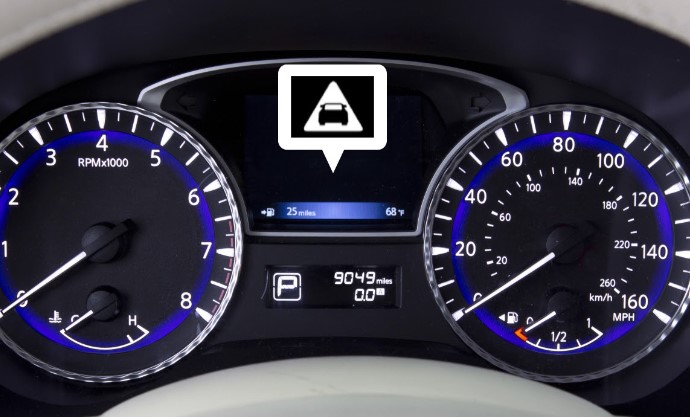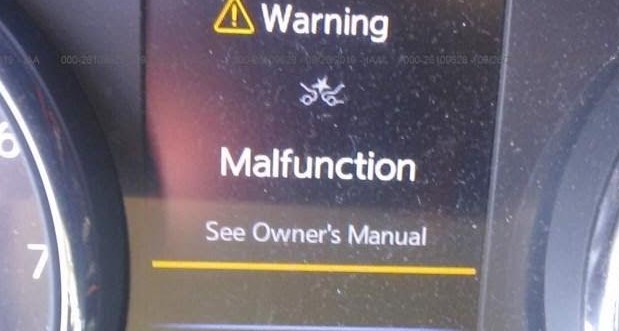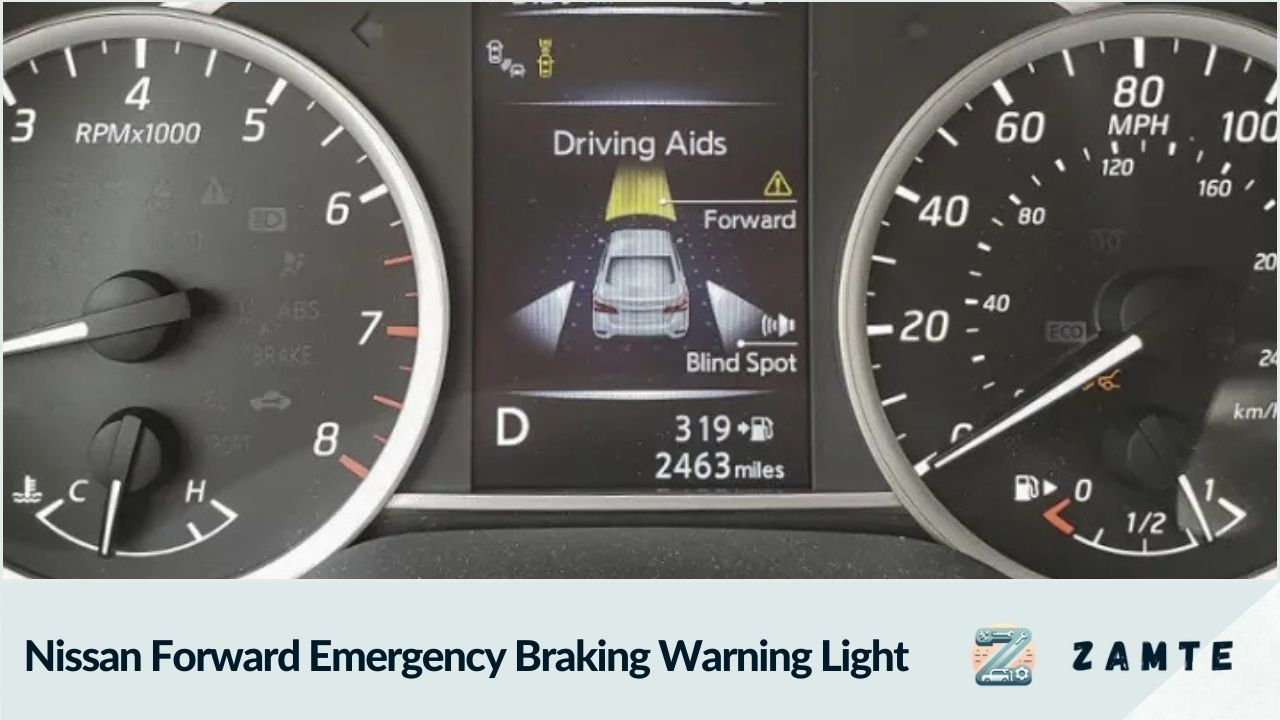The Nissan Forward Emergency Braking (FEB) system is designed to enhance driver safety by automatically applying brakes in potential collision situations. However, many Nissan owners have reported issues with this system, including false activations and warning light problems. This article will provide a detailed guide on resetting the FEB warning light and address common concerns associated with this safety feature.
| FEB System Component | Function | Common Issues |
|---|---|---|
| Radar Sensor | Detects obstacles ahead | False detections, obstruction warnings |
| Warning Light | Indicates system status | Stays on after startup, random illumination |
| Control Module | Processes sensor data | Software glitches, system deactivation |
| Brake Actuator | Applies emergency braking | Unexpected brake engagement |
Understanding the Nissan FEB System and Its Warning Light

The Nissan Forward Emergency Braking system is an advanced safety feature that uses radar technology to detect potential collisions. When the system detects an imminent crash, it warns the driver and can automatically apply the brakes if necessary. The FEB warning light on the dashboard serves as an indicator of the system's status[1].
However, many Nissan owners have reported issues with the FEB system, including false activations and persistent warning lights. These problems can be both annoying and potentially dangerous, as they may lead to unexpected braking or system failure when it's most needed[2].
Common Causes of FEB Warning Light Activation

Several factors can trigger the FEB warning light:
- Radar Sensor Obstruction: The most common cause is a blocked radar sensor, typically located behind the Nissan logo on the front grille. Dirt, snow, or debris can interfere with the sensor's function[3].
- System Malfunction: In some cases, the warning light may indicate a genuine problem with the FEB system, such as a faulty sensor or control module[1].
- Software Glitches: Some Nissan models have experienced software-related issues that cause the FEB system to malfunction or deactivate unexpectedly[2].
- Environmental Factors: Extreme weather conditions or driving on roads with poor markings can sometimes trigger false warnings or system deactivation[3].
Step-by-Step Guide to Resetting the FEB Warning Light

If you're experiencing persistent FEB warning light issues, follow these steps to attempt a reset:
- Clean the Radar Sensor: First, ensure that the radar sensor is clean and free from obstructions. Gently clean the front grille area with a soft, damp cloth[3].
- Restart the Vehicle: Turn off the engine, wait for about 30 seconds, and then restart the vehicle. This simple action can sometimes reset the system[4].
- Use the Vehicle Settings Menu: For many Nissan models, you can reset the FEB system through the vehicle's information display:
- Navigate to "Settings" in the vehicle information display
- Select "Driver Assistance"
- Choose "Emergency Brake"
- Toggle the "Forward Emergency Braking" option off and then on again[6]
- Disconnect the Battery: If the above steps don't work, try disconnecting the vehicle's battery for about 15 minutes. This can reset the vehicle's electronic systems, including the FEB[4].
- Perform a Sensor Calibration: Some Nissan models may require a sensor calibration after a reset. This typically involves driving the vehicle at a steady speed on a clear road for a short distance[1].
When to Seek Professional Assistance
If the FEB warning light persists after attempting these reset procedures, it's crucial to have your vehicle inspected by a certified Nissan technician. They can perform a thorough diagnostic check and address any underlying issues with the FEB system[2].
Known Issues and Recalls Related to Nissan FEB Systems
Several Nissan models have been subject to complaints and even class-action lawsuits regarding FEB system malfunctions. Common issues include:
- Phantom Braking: Instances where the FEB system engages unexpectedly, causing sudden deceleration[2].
- System Deactivation: The FEB system shutting off without warning, leaving drivers without this safety feature[5].
- False Warnings: Frequent false collision warnings, even in clear driving conditions[1].
Nissan has issued technical service bulletins (TSBs) for some models to address these issues. If your vehicle is affected, you may be eligible for a free repair or software update[1][2].
Preventive Measures and Best Practices
To minimize FEB system issues and maintain its effectiveness:
- Keep the Sensor Clean: Regularly clean the front grille area where the radar sensor is located[3].
- Stay Informed: Keep up with Nissan's official communications regarding potential recalls or updates for your specific model[2].
- Regular Maintenance: Ensure your vehicle undergoes regular maintenance checks, including inspections of the FEB system[1].
- Understand System Limitations: Familiarize yourself with the FEB system's capabilities and limitations as outlined in your vehicle's owner's manual[6].
By following these guidelines and understanding how to reset the FEB warning light, you can help ensure that this important safety feature functions as intended, providing you with added protection on the road.
FAQs
- How do I turn off the Nissan forward emergency braking system?
You can typically disable the system through the vehicle settings menu in your dashboard display. However, it's recommended to keep this safety feature active. - Why does my Nissan keep saying front radar unavailable?
This usually indicates an obstruction of the radar sensor. Check for dirt, snow, or debris on the front grille and clean if necessary. - Can weather conditions affect the FEB system?
Yes, heavy rain, snow, or fog can interfere with the radar sensor's function, potentially causing temporary system deactivation. - How often should the FEB system be serviced?
Have it checked during your regular vehicle maintenance, typically every 12,000 miles or annually, whichever comes first. - Is it safe to drive with the FEB warning light on?
While the vehicle can still be driven, it's best to have the system checked as soon as possible to ensure all safety features are functioning correctly.
Citations:
- 1. https://lemonlawexperts.com/nissan-faulty-braking-system/
- 2. https://www.lawsuit-information-center.com/nissan-brake-failure-lawsuit.html
- 3. https://lemonlawhelp.com/nissan-leaf-automatic-emergency-braking-problems/
- 4. https://www.vehiclehistory.com/questions/how-do-i-reset-the-nissan-forward-emergency-braking-warning-light-367479
- 5. https://lemonlawhelp.com/nissan-pathfinder-aeb-problems/
- 6. https://www.nissan.co.uk/owners/car-repair/car-owner-manual/manuals/iom/ariya/0fe0/e1/2023/turning-the-intelligent-forward-collision-warning-system-on-off-1.shtml
